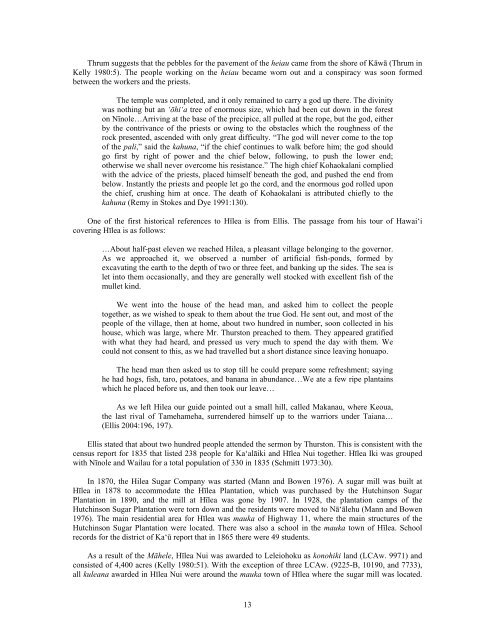Honu'apo Park Resource Management Plan
Honu'apo Park Resource Management Plan
Honu'apo Park Resource Management Plan
You also want an ePaper? Increase the reach of your titles
YUMPU automatically turns print PDFs into web optimized ePapers that Google loves.
Thrum suggests that the pebbles for the pavement of the heiau came from the shore of Kāwā (Thrum in<br />
Kelly 1980:5). The people working on the heiau became worn out and a conspiracy was soon formed<br />
between the workers and the priests.<br />
The temple was completed, and it only remained to carry a god up there. The divinity<br />
was nothing but an ‘ōhi‘a tree of enormous size, which had been cut down in the forest<br />
on Nīnole…Arriving at the base of the precipice, all pulled at the rope, but the god, either<br />
by the contrivance of the priests or owing to the obstacles which the roughness of the<br />
rock presented, ascended with only great difficulty. “The god will never come to the top<br />
of the pali,” said the kahuna, “if the chief continues to walk before him; the god should<br />
go first by right of power and the chief below, following, to push the lower end;<br />
otherwise we shall never overcome his resistance.” The high chief Kohaokalani complied<br />
with the advice of the priests, placed himself beneath the god, and pushed the end from<br />
below. Instantly the priests and people let go the cord, and the enormous god rolled upon<br />
the chief, crushing him at once. The death of Kohaokalani is attributed chiefly to the<br />
kahuna (Remy in Stokes and Dye 1991:130).<br />
One of the first historical references to Hīlea is from Ellis. The passage from his tour of Hawai‘i<br />
covering Hīlea is as follows:<br />
…About half-past eleven we reached Hilea, a pleasant village belonging to the governor.<br />
As we approached it, we observed a number of artificial fish-ponds, formed by<br />
excavating the earth to the depth of two or three feet, and banking up the sides. The sea is<br />
let into them occasionally, and they are generally well stocked with excellent fish of the<br />
mullet kind.<br />
We went into the house of the head man, and asked him to collect the people<br />
together, as we wished to speak to them about the true God. He sent out, and most of the<br />
people of the village, then at home, about two hundred in number, soon collected in his<br />
house, which was large, where Mr. Thurston preached to them. They appeared gratified<br />
with what they had heard, and pressed us very much to spend the day with them. We<br />
could not consent to this, as we had travelled but a short distance since leaving honuapo.<br />
The head man then asked us to stop till he could prepare some refreshment; saying<br />
he had hogs, fish, taro, potatoes, and banana in abundance…We ate a few ripe plantains<br />
which he placed before us, and then took our leave…<br />
As we left Hilea our guide pointed out a small hill, called Makanau, where Keoua,<br />
the last rival of Tamehameha, surrendered himself up to the warriors under Taiana…<br />
(Ellis 2004:196, 197).<br />
Ellis stated that about two hundred people attended the sermon by Thurston. This is consistent with the<br />
census report for 1835 that listed 238 people for Ka‘alāiki and Hīlea Nui together. Hīlea Iki was grouped<br />
with Nīnole and Wailau for a total population of 330 in 1835 (Schmitt 1973:30).<br />
In 1870, the Hilea Sugar Company was started (Mann and Bowen 1976). A sugar mill was built at<br />
Hīlea in 1878 to accommodate the Hīlea <strong>Plan</strong>tation, which was purchased by the Hutchinson Sugar<br />
<strong>Plan</strong>tation in 1890, and the mill at Hīlea was gone by 1907. In 1928, the plantation camps of the<br />
Hutchinson Sugar <strong>Plan</strong>tation were torn down and the residents were moved to Nā‘ālehu (Mann and Bowen<br />
1976). The main residential area for Hīlea was mauka of Highway 11, where the main structures of the<br />
Hutchinson Sugar <strong>Plan</strong>tation were located. There was also a school in the mauka town of Hīlea. School<br />
records for the district of Ka‘ū report that in 1865 there were 49 students.<br />
As a result of the Māhele, Hīlea Nui was awarded to Leleiohoku as konohiki land (LCAw. 9971) and<br />
consisted of 4,400 acres (Kelly 1980:51). With the exception of three LCAw. (9225-B, 10190, and 7733),<br />
all kuleana awarded in Hīlea Nui were around the mauka town of Hīlea where the sugar mill was located.<br />
13


